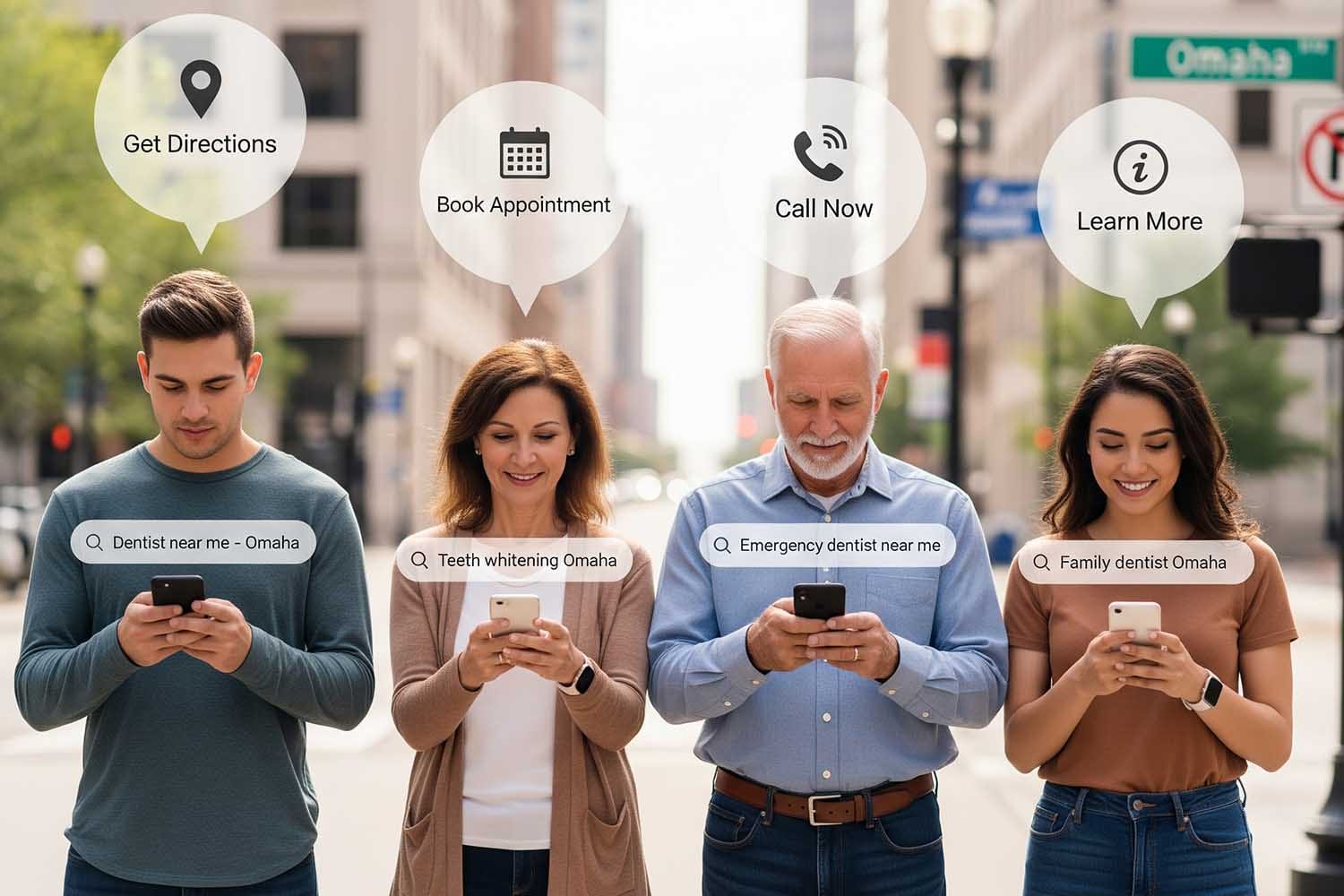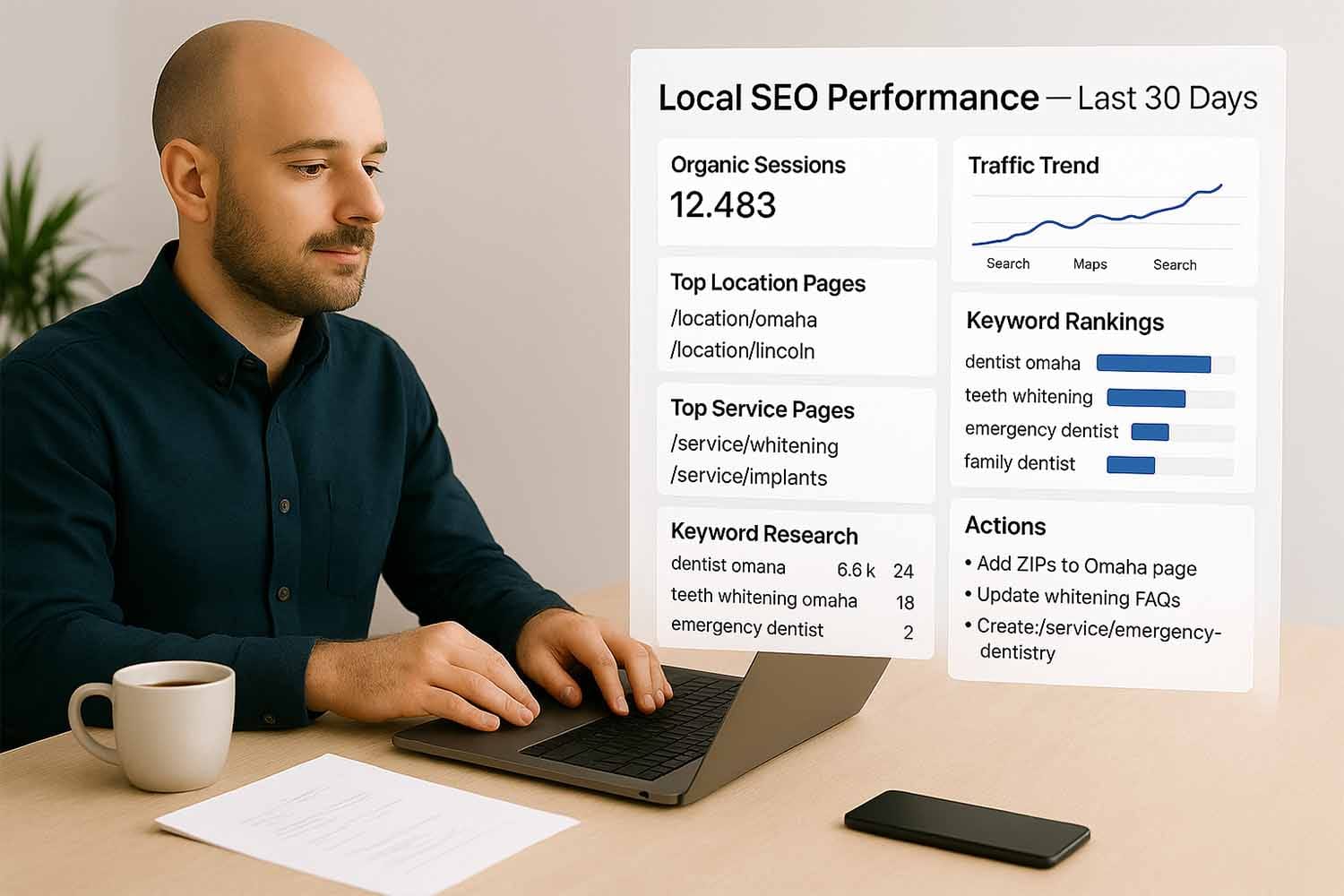Location Page vs Service Page: Understanding the Key Differences for SEO Success
Your website’s architecture could be costing you qualified leads every single day. Most local service businesses build pages without understanding the fundamental difference between location pages and service pages—then wonder why their search rankings plateau and competitors steal market share.
The distinction isn’t academic. It’s strategic. When you nail the location page vs service page strategy, you capture different types of search queries, serve distinct user intent, and dominate both local pack results and organic traffic. Get it wrong, and you’ll watch potential customers find your competitors instead.
This guide breaks down exactly when to use each page type, how to optimize them for maximum search engine visibility, and why both are essential for local SEO success. No fluff, no theory—just proven tactics that turn website visitors into booked jobs.
Key Takeaways
- Location pages target geographic-specific searches while service pages focus on specific offerings
- Location pages optimize for “service + location” keywords, service pages target “service-only” queries
- Location pages require unique local content, service pages need comprehensive service descriptions
- Both page types serve different search intents and user needs in the customer journey
- Proper implementation of both improves overall local SEO performance and search visibility
What Are Location Pages vs Service Pages?
Location pages target specific cities, neighborhoods, or service areas where your business operates. They answer the critical question: “Where do you serve?” When someone searches “plumber in Denver” or “cleaning services San Francisco,” they’re looking for location-specific results.
Service pages focus on specific services, products, or solutions your business offers, regardless of geography. They answer: “What do you do?” These pages capture searches like “emergency plumbing” or “commercial carpet cleaning” where the searcher wants to understand your capabilities first.


The power lies in how these distinct types of pages work together. Location pages help search engines understand your service areas and connect you with local searches. Service pages establish your expertise and capture broader commercial intent. Both page types create multiple entry points for potential customers at different stages of their decision-making process.
For service area businesses without physical locations in every city they serve, location pages become even more critical. You’re signaling to search engines that you actively provide services in specific areas, even without a storefront presence.
Search Intent Differences Between Location and Service Pages
Understanding search intent separates amateur SEO from strategies that actually convert. Location pages primarily target commercial intent with local modifiers—people ready to hire someone locally. When users search “electrician in Austin” or “Miami plumbing repair,” they’re past the research phase and actively seeking a provider, which is why implementing effective local SEO strategies can make a significant difference in capturing these leads.
Service pages capture both informational intent and commercial intent. Someone searching “what is drain cleaning” has informational intent—they’re learning about the service. But “drain cleaning service” shows commercial intent—they’re ready to hire. Your service pages need to satisfy both audiences.
Commercial investigation intent applies to both page types when users compare local providers or service options. A search like “best solar installation Tampa” could trigger either your location page (if optimized for that city) or your solar installation service page, depending on how google’s search results prioritize content.


Transactional intent emerges when users are ready to book or call. Both location and service pages should guide these users toward clear conversion paths—prominent phone numbers, booking forms, or consultation requests.
The key insight: location pages catch people searching with geographic urgency, while service pages educate and convert people exploring solutions. Your seo strategy needs both to capture the full spectrum of audience intent.
Keyword Strategy: Location vs Service Targeting
Location pages target geo-modified keywords that combine your services with specific places. Think “electrician in Austin,” “Miami plumbing repair,” or “Denver HVAC installation.” These local keywords often have lower search volume but much higher conversion rates because users are location-ready.
Your main keyword research for location pages should include city names, neighborhoods, and even local landmarks. If you serve customers in North Austin, optimize for that specific area. People searching for services often include hyperlocal terms like “near downtown” or “in Westlake.”
Service pages target service-focused keywords without geographic modifiers. “Emergency plumbing,” “commercial electrical installation,” or “whole-house rewiring” capture users investigating specific solutions. These keywords typically have higher search volume but varying levels of commercial intent.
Related keywords for service pages should cover service variations, industry terminology, and problem-solving phrases. Someone might search “fix leaking faucet,” “faucet repair,” or “kitchen faucet replacement”—all targeting your plumbing service page from different angles.
The overlap happens with commercial investigation searches. “Best plumbing company Austin” could reasonably target either your Austin location page or your main plumbing service page, depending on your url structure and content focus.
Content Strategy and Optimization Differences
Location Page Content Requirements
Location pages demand unique content for each service area to avoid duplicate content penalties that tank your keyword rankings. This isn’t about swapping city names in template copy—search engines spot that immediately.
Each location page needs location specific information that proves your local presence. Include neighborhood details, local landmarks, and area-specific service considerations. If you’re a roofing company serving coastal areas, mention salt air corrosion. For mountain regions, discuss snow load requirements.
Local customer testimonials and case studies from that specific area build trust and provide fresh, unique content. A testimonial from “Sarah in Westlake” carries more weight on your Austin service area page than generic reviews.
Service area descriptions should clearly define geographic boundaries—specific zip codes, neighborhoods, or driving distances you serve from that location. This helps search engines understand your coverage and helps potential customers know if you serve them.


Physical location details matter even for service area businesses. If you have an office, warehouse, or dispatch center in the area, include that address, hours, and contact information. For areas without physical locations, focus on service availability and response times.
Service Page Content Requirements
Service pages require comprehensive descriptions that establish expertise and answer customer questions before they ask. Don’t just list what you do—explain your process, why your approach works, and what makes your service delivery superior.
Benefits and features need clear separation. Features describe what’s included (“24-hour emergency response,” “licensed and insured technicians”). Benefits explain what that means for the customer (“no overtime charges,” “peace of mind protection”).
Before and after examples, case studies, and project galleries provide social proof while adding visual appeal. High quality images of actual work performed help users visualize results and improve page engagement signals that search engines track.
Service-specific FAQs address common concerns and objections while naturally incorporating related keywords. “How long does HVAC installation take?” and “Do you offer financing?” capture long-tail searches while improving user experience.
Pricing information, even if general ranges, helps qualify leads and improves conversion rates. Many businesses avoid pricing, but transparency builds trust and filters out price shoppers who aren’t good fits.
Technical SEO Implementation
Location Page Technical Elements
LocalBusiness schema markup tells search engines exactly what your location page represents. Include specific address data (even for service areas), phone numbers, service radius, and hours of operation. This structured data helps google find your business listing information and improves local search results visibility.
URLs should follow a logical structure like /locations/city-name/ or /service-area/neighborhood/ that both users and search engines can easily understand. Clean url structure also makes internal linking more intuitive and helps organize your website architecture.
Title tags for location pages should combine your main service with the specific location: “Plumbing Services in Denver, CO | [Company Name]” clearly signals relevance for local searches. Keep titles under 60 characters to avoid truncation in search results.
Meta descriptions should highlight local service availability and unique area advantages like “Serving Denver metro for 15+ years” or “Same-day service to downtown Austin.” These snippets can significantly impact click-through rates from google search results.


Local images with geo-specific alt text and descriptive file names reinforce location relevance. Instead of “team-photo.jpg,” use “austin-plumbing-team-2024.jpg” with alt text describing your local team serving that specific area.
Service Page Technical Elements
Service schema markup describes your specific offerings and helps search engines categorize your business capabilities. This structured data can trigger rich snippets showing service details, pricing, and availability directly in search results.
URL structure for service pages should be equally intuitive: /services/service-name/ or /what-we-do/service-category/ creates clear navigation paths. Consistent structure across all service pages improves crawlability and user experience.
Title tags should emphasize service benefits and unique selling propositions: “Emergency Plumbing Repair Services | 24/7 Response” focuses on the value proposition rather than just service description.
Meta descriptions for service pages should highlight expertise, specialization, and compelling reasons to choose your business. “15+ years emergency plumbing experience. Licensed, insured, upfront pricing” addresses key customer concerns upfront.
Internal Linking Strategy
Location pages should link to all relevant service pages available in that area, creating logical navigation paths and strengthening seo signals for combined “service + location” queries. If your Austin location offers both plumbing and HVAC services, link to both service pages with contextual anchor text.
Service pages should link to relevant location pages where that service is available. Your emergency plumbing service page should link to all cities where you provide emergency services, helping users find local availability quickly.
Site architecture should follow a hub-and-spoke or pyramid structure with main service and location pages at the top level, then more specific pages underneath. This organization helps search engines understand your business scope and improves crawlability across all relevant pages.
Contextual anchor text that includes both service and location terms (“HVAC repair in North Austin”) provides additional relevance signals while maintaining natural readability. Avoid over-optimization with exact-match anchor text on every internal link.
The goal is creating logical pathways between related content that serve user needs first. When someone lands on your “Air Conditioning Repair” service page, they should easily find location-specific information for their area without hunting through navigation menus.
User Experience Considerations
Location pages should prioritize quick access to contact information, service area confirmation, and booking options. Users need immediate clarity that you serve their location and how to reach you. Mobile-optimized contact buttons and click-to-call functionality are essential since most local searches happen on mobile devices.
Service pages need to educate first, then convert. Provide comprehensive information about your service process, what’s included, and what to expect. Clear calls-to-action should guide users toward the next logical step—whether that’s calling for emergency service or requesting a consultation.
Both page types must load quickly and display properly on mobile devices. Google considers page speed a ranking factor, and slow-loading pages increase bounce rates while decreasing conversion potential. Use tools like google analytics to monitor user behavior and identify optimization opportunities.


Navigation should help users easily move between location and service information. Someone who finds your Austin location page should easily discover your full range of services, and service page visitors should quickly find local availability.
Clear conversion paths reduce friction in the customer journey. Whether the goal is phone calls, form submissions, or appointment bookings, make the desired action obvious and accessible from every page.
When to Use Location Pages vs Service Pages
Create location pages for every city, neighborhood, or distinct service area where you actively provide services and can create unique, valuable content. If you regularly serve customers in multiple locations, each deserves its own optimized page targeting local search queries.
Service pages should exist for every distinct service offering or solution category. If customers specifically search for that service by name or if the service requires detailed explanation, it needs its own page. Specialized services like “emergency drain cleaning” might warrant separate pages from general “drain cleaning” if search volume supports it.
Combination pages work well for high-value opportunities where “service + location” searches have substantial volume. “Emergency plumbing Austin” might justify its own landing page if competition and search volume are significant enough.
Service area businesses without physical locations should still create location pages for areas they regularly serve. These pages focus on service availability, response times, and local expertise rather than physical address information.
Avoid creating thin location pages for areas where you rarely work or new pages for every possible service variation. Quality trumps quantity—ten well-optimized, content-rich pages outperform fifty thin pages that provide minimal value to users or search engines.
Common Mistakes to Avoid
Creating duplicate content across multiple location pages ranks as the most dangerous mistake. Swapping city names in otherwise identical content triggers duplicate content penalties that can devastate your search rankings. Each location page must provide unique value and location-specific information.
Making service pages too generic without any local relevance wastes opportunities for local businesses. While service pages shouldn’t be location-specific, they should acknowledge your service areas and include calls-to-action that connect to location-specific information.
Over-optimizing for cities where you don’t actually provide services misleads both search engines and potential customers. If you can’t realistically serve an area within reasonable time and cost parameters, don’t create a location page for it.
Neglecting to update location pages with current information creates user frustration and search engine distrust. Outdated hours, service areas, or contact information directly impacts user experience and local SEO performance.
Creating too many thin pages that lack substantial content dilutes your website’s authority and wastes crawl budget. Focus on fewer, high-quality pages that thoroughly address user needs rather than numerous shallow pages targeting every possible keyword combination.
Forgetting schema markup implementation leaves money on the table. Both location and service pages benefit from structured data that helps search engines understand and display your content in rich snippets and local search features.
Measuring Success for Location vs Service Pages
Track local keyword rankings for location pages using google search console to monitor performance for geo-modified search terms. Look for improvements in positions for “service + city” combinations and monitor local pack appearances where applicable.
Service page success metrics should focus on both keyword rankings and conversion rates. Monitor rankings for service-specific terms while tracking which pages generate the most leads, phone calls, or appointment bookings.
User behavior metrics provide insights into content effectiveness. Pages with high bounce rates or low time-on-page scores might need content improvements or better user experience optimization. Google analytics reveals which pages successfully engage visitors and guide them toward conversion.
Local citation consistency and business listing performance support location page effectiveness. Monitor your google business profile insights to see how location pages influence local search visibility and customer actions like direction requests or phone calls.
Lead generation and revenue attribution remain the ultimate success measures. Track which pages generate the most valuable customers and focus optimization efforts on highest-performing content while improving or consolidating underperforming pages.
FAQ
Should I create separate location pages for each city I serve? Yes, if you actively provide services there and can create unique, valuable content for each location. Don’t create pages for areas you rarely serve or where you can’t provide distinct local information.
Can I combine location and service information on the same page? Combination pages work well for specific service-location combinations with high search volume, like “emergency plumbing Austin.” Just ensure the content provides substantial value beyond what separate pages would offer.
How many service pages should I create? Create one page for each distinct service offering that provides sufficient value and content. If a service requires detailed explanation or customers specifically search for it by name, it deserves its own page.
Do location pages help with Google Business Profile rankings? Yes, location pages support local SEO efforts and can improve visibility in local search results. They provide additional signals about your service areas and local expertise.
Should location pages link to all service pages? Link to services that are actually available in that location. Maintain relevance and user experience by only connecting related content that serves customer needs in that specific area.




